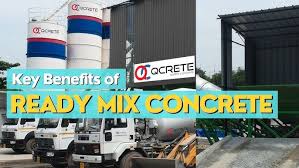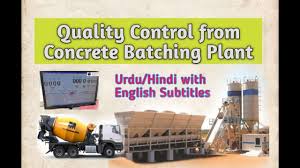Table of Contents
ToggleWhat is Ready Mix Concrete: Explore its 5 Benefits, Uses, and Applications
Introduction
Ready mix concrete (RMC) has revolutionized the construction industry by providing a reliable, high-quality material for a wide range of projects. It is pre-mixed in a controlled environment and delivered to construction sites, ensuring consistent quality and reducing the need for on-site mixing. This article explores the intricacies of ready mix concrete, including its benefits, uses, and applications, offering a comprehensive guide for both industry professionals and DIY enthusiasts.

What is Ready Mix Concrete?
Ready mix concrete is a type of concrete that is batched and mixed in a factory or batching plant before being delivered to the construction site. It’s designed to be used immediately upon arrival, ensuring that it meets the specific requirements of each project. The process involves:
- Batching: Accurate measurement of raw materials (cement, aggregates, water, and admixtures).
- Mixing: Combining these materials in a concrete mixer to achieve a homogeneous mixture.
- Delivery: Transporting the mixed concrete to the site using a transit mixer, which keeps the concrete in motion to prevent it from setting before use.
The primary advantage of RMC is the ability to achieve high consistency and quality, which is essential for constructing durable and reliable structures.
Components of Ready Mix Concrete
Understanding the components of ready mix concrete helps in grasping how it achieves its strength and durability:
- Cement:
- Type: Generally, Ordinary Portland Cement (OPC) is used, but other types like Portland Pozzolana Cement (PPC) or blended cements may be used depending on the requirements.
- Function: Acts as a binding agent that holds the aggregates together when the concrete hardens.
- Aggregates:
- Coarse Aggregates: Usually crushed stone or gravel that provides strength and bulk to the concrete.
- Fine Aggregates: Sand that fills the voids between coarse aggregates and improves the workability of the concrete.
- Water:
- Quality: Clean and free from impurities that could affect the strength and durability of the concrete.
- Function: Reacts with the cement to start the hydration process, which forms the hardened structure of concrete.
- Admixtures:
- Types: Chemical additives like superplasticizers, retarders, or accelerators.
- Function: Modify the properties of the concrete, such as its setting time, workability, or strength.
Benefits of Ready Mix Concrete
Ready mix concrete offers several advantages over traditional on-site mixing:

- Consistent Quality:
- Controlled Environment: RMC is mixed in a controlled environment, ensuring uniform quality in every batch.
- Precise Proportions: Automated batching ensures accurate proportions of materials, leading to consistent strength and durability.
- Time Efficiency:
- Quick Setup: Since the concrete is pre-mixed, it eliminates the need for on-site mixing, reducing preparation time.
- Faster Project Completion: Rapid placement of concrete accelerates construction schedules.
- Reduced Labor Costs:
- Minimized Manual Work: On-site mixing requires additional labor for mixing and handling, which RMC eliminates.
- Labor Savings: Reduces the need for mixing equipment and manual labor, translating to lower overall costs.
- Enhanced Durability:
- High-Strength Mixes: Consistent quality control leads to stronger, more durable concrete.
- Longevity: Properly mixed and cured RMC can withstand harsh environmental conditions.
- Environmentally Friendly:
- Reduced Waste: Precise batching reduces material waste and minimizes environmental impact.
- Sustainable Practices: Many RMC plants incorporate sustainable practices like recycling water and materials.
Types of Ready Mix Concrete
Different types of ready mix concrete are designed to meet specific project requirements:

- Standard Ready Mix Concrete:
- Characteristics: General-purpose mix suitable for most construction needs.
- Uses: Foundations, pavements, and general structural applications.
- High-Strength Concrete:
- Characteristics: Engineered to achieve higher compressive strength.
- Uses: High-rise buildings, bridges, and other heavy-load structures.
- Self-Compacting Concrete:
- Characteristics: Highly flowable and can fill formwork without mechanical vibration.
- Uses: Complex or intricate formwork where vibration is difficult.
- Fiber-Reinforced Concrete:
- Characteristics: Contains fibers (steel, glass, or synthetic) to improve tensile strength and
reduce cracking.
- Uses: Industrial floors, pavement, and structures exposed to high stress or harsh conditions.
Uses of Ready Mix Concrete
Ready mix concrete is versatile and suitable for a variety of applications:
- Residential Construction:
- Foundations: Provides a strong and stable base for residential buildings.
- Driveways and Sidewalks: Ideal for creating smooth, durable surfaces that withstand daily use.
- Patios and Walkways: Offers a wide range of finishes and decorative options for outdoor spaces.
- Commercial Buildings:
- Office Complexes: Ensures structural integrity and durability for commercial properties.
- Shopping Centers: Used for foundations, floors, and paving, accommodating high foot traffic and heavy loads.
- Infrastructure Projects:
- Roads and Pavements: Provides a durable surface for highways, streets, and parking lots.
- Bridges and Tunnels: High-strength and specialized mixes are used to ensure safety and longevity.
- Dams and Reservoirs: Designed to handle massive loads and resist water erosion.
- Industrial Applications:
- Factories and Warehouses: Delivers robust flooring and structural elements capable of supporting heavy machinery and loads.
- Storage Tanks: Used for constructing tanks and silos that require high durability and resistance to various chemicals.
Applications of Ready Mix Concrete
Ready mix concrete is employed in various applications that highlight its flexibility and effectiveness:
- Foundation Works:
- Types of Foundations: Includes footings, pads, and pile caps.
- Benefits: Provides a stable and level base, ensuring the structural integrity of buildings.
- Pavements and Roads:
- Surface Durability: RMC offers a smooth, even surface that can withstand heavy traffic and adverse weather conditions.
- Long-Term Performance: Reduces maintenance needs and extends the lifespan of roadways.
- Precast Structures:
- Components: Beams, slabs, columns, and walls are manufactured off-site and then assembled on-site.
- Advantages: Allows for faster construction and high precision in creating complex shapes and designs.
- Architectural Concrete:
- Design Possibilities: Includes exposed aggregate, colored concrete, and stamped patterns.
- Aesthetic Appeal: Enhances the visual appeal of buildings and landscaping elements.
Choosing the Right Mix for Your Project
Selecting the appropriate ready mix concrete involves several considerations:
- Project Requirements:
- Load-Bearing Capacity: Determine the strength needed based on the structural requirements.
- Environmental Conditions: Consider exposure to elements like moisture, temperature, and chemicals.
- Strength and Durability:
- Compressive Strength: Choose a mix with the required strength to support the intended load.
- Durability Features: Look for properties like resistance to freezing, thawing, and abrasion.
- Workability:
- Ease of Placement: Ensure the mix is workable enough to be easily placed and finished.
- Formwork Complexity: For intricate designs, select a mix with good flowability.
- Budget:
- Cost Efficiency: Balance the performance requirements with budget constraints.
- Long-Term Value: Consider the cost of maintenance and potential savings from reduced repairs.
How Ready Mix Concrete is Delivered
Ready mix concrete is delivered using specialized equipment:
- Transit Mixers:
- Design: Equipped with a rotating drum to keep the concrete in motion.
- Function: Ensures the concrete remains fresh and workable during transportation.
- Delivery Scheduling:
- Timing: Concrete is typically delivered based on the project’s schedule to avoid delays.
- Coordination: Efficient coordination with the construction team is essential to ensure timely placement.
Quality Control in Ready Mix Concrete Production
Maintaining high-quality standards is crucial for reliable performance:

- Batching:
- Accuracy: Automated systems ensure precise measurement of ingredients.
- Consistency: Regular checks are conducted to maintain the desired mix proportions.
- Mixing:
- Homogeneity: The mixing process is designed to achieve a uniform consistency.
- Testing: Quality tests, including slump tests and compressive strength tests, are performed to verify mix quality.
- Testing and Inspection:
- Laboratory Tests: Samples are analyzed for strength, workability, and durability.
- On-Site Testing: Additional tests may be conducted to ensure the concrete meets project specifications.
Challenges and Considerations
While ready mix concrete offers many benefits, there are challenges to address:
- Timing:
- Setting Time: Concrete must be used within a specific time frame to avoid setting issues.
- Scheduling: Proper scheduling and coordination are required to ensure timely delivery and placement.
- Transportation Limitations:
- Distance: Long transportation distances can affect the quality of the concrete.
- Temperature Control: Maintaining appropriate temperatures during transit is essential for quality.
- Weather Conditions:
- Extreme Temperatures: High or low temperatures can impact the setting and curing of concrete.
- Mitigation: Use of appropriate admixtures and curing methods can help manage weather-related challenges.
Sustainability and Environmental Impact
The concrete industry is increasingly focusing on sustainability:
- Recycling and Reuse:
- Recycled Materials: Incorporation of recycled aggregates and by-products like fly ash reduces waste.
- Circular Economy: Promotes the reuse of concrete materials from demolition projects.
- Energy Efficiency:
- Optimized Production: Advances in technology reduce energy consumption in batching and mixing processes.
- Emission Reductions: Improved practices aim to lower greenhouse gas emissions.
- Water Management:
- Conservation: Efficient water use in production and recycling of water minimizes environmental impact.
- Quality Control: Ensuring the quality of water used in mixing is essential for maintaining concrete performance.
Future Trends in Ready Mix Concrete
The concrete industry is evolving with innovative solutions:
- Advanced Admixtures:
- New Developments: Innovations in chemical additives enhance concrete properties like strength, durability, and sustainability.
- Customized Solutions: Tailored admixtures address specific project needs and environmental conditions.
- Smart Concrete:
- Self-Healing Concrete: Incorporates materials that repair cracks autonomously, extending the lifespan of structures.
- Embedded Sensors: Integration of sensors to monitor the health and performance of concrete over time.
- Sustainable Practices:
- Low-Carbon Options: Development of low-carbon concrete alternatives to reduce environmental impact.
- Green Certifications: Adoption of certifications and standards for sustainable concrete practices.
Conclusion
Ready mix concrete is a vital component in modern construction, offering numerous benefits in terms of quality, efficiency, and sustainability. Understanding its components, benefits, and applications allows builders and developers to make informed choices that enhance the success and longevity of their projects. Whether you are undertaking a residential renovation or a large-scale infrastructure project, ready mix concrete provides a reliable solution that meets the demands of today’s construction industry.
If you want to get more knowledge about this so read more.
If you want more articles about Civil Engineering click on link.





